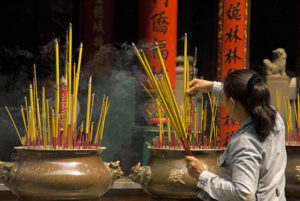
Thien Hau Pagoda Buddhist Temple in Saigon’s Chinatown. Photo by Dennis Cox/WorldViews
In Part I of Robert Waite’s two-part series on traveling to Vietnam, Vietnam Visit Stirs Emotions for Boomers, Bob recounted his recent visits to Hanoi and Halong Bay.
In this post, he travels to Saigon (Ho Chi Minh City) and the remarkable Cu Chi Tunnel complex dug by the Viet Cong outside the city — but much closer to it than you might imagine.
Saigon itself is a bustling city that evokes stark memories of the Vietnam War, but is also now a prime “foodie” destination and a place to drink at a bar made famous by big-name war correspondents:
By Robert Waite
Part II of a two-part series.
Ho Chi Minh City, Vietnam – The thing about name changes is that they often don’t stick. Take Mumbai, for example. The Indian national government decided that “Bombay” was a colonial relic and that, henceforth, Mumbai would be the official name of the country’s largest city and financial hub.
It made sense – except that years later, when I was introduced to the city’s mayor and asked how things were going in Mumbai, he smiled and said, “Please, Bombay. Nobody pays any attention to the official name.”
Certainly this seems to be the case in what was once Saigon.
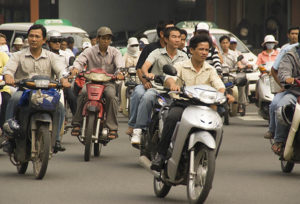
Motorbike traffic in downtown Saigon — it’s an adventure. Photo by Dennis Cox/WorldViews
Its official name, adopted after the fall of the city to Viet Cong and North Vietnamese forces in the 1970s, is Ho Chi Minh City. In practice it sometimes seems as if the city’s nine million inhabitants never got the memo – everywhere you go people say “Saigon.” Sometimes they might throw in Ho Chi Minh City, or its acronym, HCMC.
Whatever you call it – and I will call it Saigon here – this former capital of South Vietnam remains Vietnam’s most vibrant urban area, with an energy and bustle surpassing that found in Hanoi.
After checking into the venerable Hotel Majestic Saigon, my wife and I kicked off our stay by climbing aboard a couple of Vespa motor bikes for what was billed as a “Saigon Afternoon Foodie Tour.”
We had already observed the city’s traffic, mostly in the form of endless streams of motorbikes, tightly packed together and moving quickly, from our balcony. We wondered how anyone ever crosses the street in such chaos – and we congratulated ourselves for hiring guides to pilot our Vespas.
Foodie Heaven
Food is important everywhere in Vietnam, but nowhere more so than Saigon. One can find some of the country’s finest and most expensive restaurants in the city, offering Vietnamese, French or Chinese cuisine (or a blend of all three).
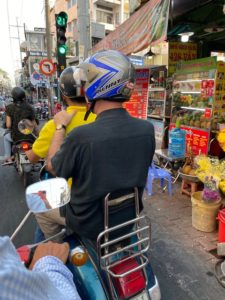
The Saigon “Foodie Tour” was conducted aboard Vespas. Photo by Robert Waite.
But you can also find culinary delight in the most modest of food stands or tiny kitchens. It was to these tiny kitchens, some located across the Saigon River, some back across the bridge, to which we headed.
Although we had tried cooking Vietnamese in North America, it had never matched what we were served in these little restaurants. There was intentional variety – some of the spots selected by our guide specialized in seafood; others in pho, fried rice or vegetable dishes. Most could seat, at max, six people.
For all intents and purposes, we were eating in family’s kitchen and the freshness of the ingredients, especially items like lemon grass, galangal, mint, and various types of seafood, made all the difference.
Food was a consistent theme during our time in Saigon.
We were later joined by my wife’s sister and close friends, a family of three from Rhode Island. Together we signed up for a “Saigon Cooking School,” which included a guided tour of several food markets to select ingredients and a cooking class where we prepared (and then consumed) a three-course meal.
Historic Palace
But there is much more to see and do in Saigon beyond eating.
For those interested in politics and the Vietnam War – or the American War, as the Vietnamese call it – a visit to the War Remnants Museum and to the Reunification Palace is a must.
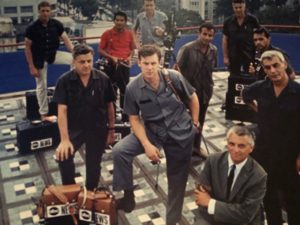
Peter Jennings (center) was among the journalists in Saigon covering the war. Photo from ABC News.
The Palace might seem familiar to Boomers – it was the Presidential Palace when Saigon was the capital of South Vietnam and was often used as a backdrop by foreign broadcast journalists during the late 1960s and the early 1970s.
Today it is open to the public and is sometimes used for ceremonial events. It was constructed in 1966 after South Vietnam’s own Air Force, in an attempt to overthrow a deeply unpopular leader, President Ngo Dinh Diem, bombed and severely damaged the predecessor structure.
The building itself is somewhat architecturally reminiscent of the Kennedy Center in Washington, D.C. But unlike the Kennedy Center, it has a vast and deep bunker below and a fast-getaway helipad adjacent.
Images of the April 30, 1975 entry by Viet Cong forces and tanks onto the Palace grounds are only rivaled in memory by the ones depicting the evacuation of American Embassy staff from the building’s rooftop.
War Remnants Museum
The nearby War Remnants Museum, which was founded in September 1975, only months after the fall of Saigon and the unification of the country under the Communists, is an experience at once sobering, inspiring and somewhat infuriating.
The museum’s expressed purpose is “display exhibits on war crimes inflicted on Vietnamese by foreign aggressive forces” and to “preserve global peace (and) promote friendship and solidarity among nations.” Outside are U.S. artillery pieces, tanks and other left- behind military flotsam and jetsam.
Inside, the museum does a very good job of documenting the ravages of war, both against Colonial France and the U.S. An exhibit regarding Agent Orange, the toxic defoliant, featuring drawings by children, is particularly moving. I also found the temporary exhibit honoring the many photographers who created visual images of the war, both foreign and Vietnamese, to be excellent.
But there was no mention of any atrocities committed by the North Vietnamese forces or the Viet Cong on their own people. As ever it was thus: victors get to write their version of history.
Self-Sacrifice
Another spot definitely worth visiting is the memorial honoring Thich Quang Duc, the Buddhist monk who in 1963 self-immolated at an intersection not far from the Presidential Palace to protest the treatment of Buddhists by then-South Vietnam President Diem, who was Roman Catholic.
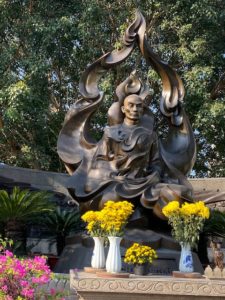
A memorial marks the spot where a Buddhist monk self-immolated in protest of the war. Photo by Robert Waite.
New York Times photographer Malcolm Brown captured the moment with an image that shocked viewers around the world – and caused President John Kennedy to question the wisdom of supporting a regime that was repressing its religious majority.
More than in Hanoi or Hue, we observed clusters of U.S. Vietnam veterans from time to time, in places like the War Remnants Museum and in and around our hotel. One could not help but notice that they were getting on in years. Much as the numbers of WWII vets visiting places like Normandy have dwindled, so too will the number of vets returning to Vietnam.
As a journalist, I was tempted to ask them how they found the experience of visiting places like the War Remnants Museum and returning to Vietnam. But it seemed more respectful to leave them to their thoughts.
Five O’clock Follies
Speaking of journalists, I made a special point of visiting the Saigon Saigon Bar, perched atop the Caravelle Hotel. Opened in 1959, it features great skyline views and a daily two-for-one Happy Hour.
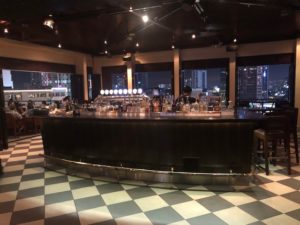
The Saigon Saigon Bar, scene of the “Five O’Clock Follies” during the war. Photo by Robert Waite
But what made it of interest to me was that this rooftop was one of the venues (along with the Rex Hotel) for the U.S. military’s daily briefing sessions with various news correspondents, including Canadians Morley Safer and Peter Jennings and Americans like the New York Times’ David Halberstam and UPI’s Kate Webb.
These briefings were so removed from reality, peppered as they were with inflated body counts and wildly optimistic predictions regarding “progress,” that they were dubbed “The Five O’clock Follies.” Today at 5 p.m. at Saigon Saigon you get Happy Hour.
Cu Chi Tunnels
There is much else to see and do (and eat!) in Saigon, but we wanted to head out of the city to see the Cu Chi Tunnel complex. This historic site preserves an amazing network of underground tunnels and spaces used by the Viet Cong during the war.
It is remarkable just how close some of these tunnels were to the city itself – and how well they were concealed. The main complex was about 40 miles from Saigon, but some reached right to the city’s outskirts.
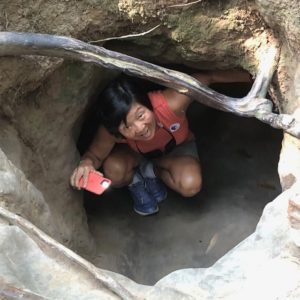
Part of the Viet Cong’s Cu Chi Tunnel complex outside Saigon. Photo by Robert Waite.
Begun in 1960, they were greatly expanded over time and eventually contained underground medical and dining facilities, weapon manufacturing and repair spaces, as well as sleeping areas.
You can actually crawl through the tunnels if you wish – but expect a tight fit. My 100-pound spouse did so; I chose to explore the larger rooms, which can handle wide-bodied Westerners.
Prior to exploring the tunnels you can watch a short film describing the strategic purpose of setting up a base so close to the capital. There is also a cut-away model of the system that shows how it operated at many subterranean levels.
One of the ingenious features was the system for diverting water from the tunnel entrances in a country that can have torrential rain at times.
If nothing else, Cu Chi provides further evidence of just how determined many Vietnamese were to unite their country and drive out foreigners – just as they had the Chinese and French prior to the arrival of Americans.
A New But Sobering Year
Heading back to Saigon, we made a brief but instructive stop at a rubber plantation, which was the backbone of the French colonial economy – but broke the backs of many Vietnamese laborers who were often treated as near-slaves.
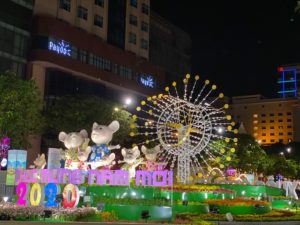
Colorful Tet celebrations mark the start of the Vietnamese New Year. Photo by Robert Waite.
Not only was there human cost, but huge swaths of semi-tropical and ecologically important terrain was cleared to plant rubber trees in straight rows.
As we concluded our visit we had a final meal at one of the better restaurants, Vietnam House, and then walked over a few blocks to enjoy the Tet Festivities, which were just getting underway.
It was late January by our calendar, but the beginning of a New Year in Vietnam. Little did any of us know that COVID would pull the curtain down so soon after – we were lucky to be among the last to visit before the world stopped traveling.
When things start up again Saigon – and Vietnam – deserve a place near the top of your travel list.
If You Go
We went to Saigon in January, when temperatures are less oppressive and rainfall lighter. The Tet Lunar Festival’s timing varies from year to year from late January to early February – it is worth taking in, but be warned that prices are higher and accommodations and transport can be difficult to come by.
We stayed at the Majestic Saigon Hotel in the city. There are newer hotels, but we enjoy the more historic properties. Ask for a room facing the river.
Our Saigon Foodie Tour was provided by Vespa Adventure Tours. You haven’t lived until you’ve moved through Saigon traffic on a motor scooter – surrounded by thousands of other motor scooters.
On the other hand, crossing the street on foot in Saigon is a life-threatening challenge, since traffic lights are scarce, even on major thoroughfares. Our advice is to observe others and then give it a try – amazingly, if you push forward at a steady pace, without stopping, the scooters, motorbikes, and cars should part like the Red Sea. Or at least they did for us.
Our land travel arrangements were made by JBC Travel of Ottawa, Canada. We flew into Vietnam via China Airlines and out via EVA. We would recommend the latter over the former.
Author Bio: Contributing writer Robert Waite has written on travel for nearly 50 years; his previous posts for clarknorton.com include such far-flung destinations as Namibia, Rwanda, Albania, Cambodia (Angkor Wat), Laos, and Guatemala. He is also a professor at Seneca College in Toronto and Managing Partner at Waite + Co., a communications consulting firm with offices in Boston, Ottawa and Toronto.
You might also enjoy an earlier five-part series, “Vietnam Diary,” by guest contributor Myles Stone, starting with “The Local Fixer,” a neighborhood fixture in Hoi An, Vietnam, where Stone, a physician, worked for several months.












Leave a Reply